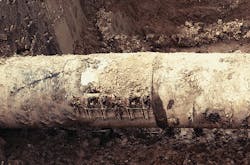THE SAN FRANCISCO Public Utilities Commission (SFPUC) is the third largest municipal utility in California, serving 2.7 million residential, commercial and industrial customers in four Bay Area counties. Approximately 1,240 miles of distribution pipe deliver water to the residents within San Francisco.
These pipes are comprised of buried cast iron (61 percent), ductile iron (29 percent) and steel (10 percent), with 184 miles of cast iron pipe being more than 100 years old and another 386 miles of cast iron pipe being 75–100 years old.
In 2011, SFPUC evaluated the risks of in-city water distribution lines as part of a larger effort to prioritize main replacements before breaks happen. As part of this effort, SFPUC developed total risk scores for all of its San Francisco distribution pipes. This scoring resulted in approximately 25 percent of the system (about 310 miles) being identified for a priority replacement goal of 15 miles per year. The assessment criteria for this model are “priority” pipelines, hydraulic improvements, operational improvements, recent main breaks, seismic backbone and other replacement projects in the area.
Stemming from the evaluation, SFPUC began a capital improvement program that strives to annually replace several miles of its aging water distribution mains at a rate of 15 miles per year. Even with this increase, however, the replacement need for aging pipes kept continuing to grow.
As a result, SFPUC has been actively seeking more innovative ways to efficiently maximize its funding by using proactive strategies to identify, prioritize and extend the life of pipes that, while old, may not need a timely replacement.
USING MACHINE LEARNING TO SUPPLEMENT EXISTING PIPE REPLACEMENT METHODOLOGY
In 2016, Fracta began developing a cloud-based software-as-a-service (SaaS) using artificial intelligence (AI) and Machine Learning to assess the condition of drinking water mains to help large utilities better assess pipe replacement decisions and allocate funding.
The Fracta solution calculates and visualizes the Likelihood of Failure (LOF) for every water pipe segment in a utility. This LOF score represents the mathematical probability of pipe failure. Recently, Fracta expanded its solution to assess the Consequence of Failure (COF), which determines the severity of a failure and quantifies the direct and indirect costs of water main failures.
When LOF and COF are calculated, they’re then placed in the Business Risk Analysis (BRE) formula:
LOF (%) x COF ($) = BRE ($)
BRE is calculated in terms of direct and indirect costs.
To support its capital improvement program, SFPUC allowed Fracta to use its distribution data and collaborated with engineers and scientists from Fracta to develop a large, data-driven method to further support pipe replacement decisions.
SUPPORTING REPLACEMENT EFFORTS FOR SFPUC
In 2017, Fracta modeled SFPUC’s 1,240 miles of drinking water pipes in San Francisco and subsequently commercialized its Pipeline Condition Assessment model in 2017. In 2018, SFPUC incorporated Fracta’s LOF output as additional assessment criteria and is now using Fracta as a supplemental tool for selecting which pipes to replace. This is applied in cases of “borderline” pipes, where SFPUC’s existing risk score does not provide clear direction on a pipe’s need for immediate replacement.
After taking into account the difficulties of facilitating construction projects in a dense urban environment, SFPUC currently achieves a replacement rate of 10–13 miles of pipe per year. This is a large improvement over the previous replacement rate of 3–5 miles per year.
However, even with these improvements, the original goal of replacing 15 miles per year is not sufficient to keep up with the aging that occurs with the utility’s water mains. Fracta helps SFPUC to prioritize replacement. These efforts have been successful, as they strategically defer aging lines that can be deferred while focusing on lines that need replacement.
OPTIMIZING DECISIONS – REDUCING BREAKS
In an effort to select and prioritize projects, SFPUC continues to supplement its current methodology with AI and Machine learning to better assess and predict a pipeline’s LOF.
For example, using AI and Machine Learning, SFPUC can predict pipe failures on pipes that have never failed before. Meaning, if a pipe had a failure on one block, the Fracta solution can predict if pipelines in the area will have a failure within the next five years based on that failure, pipe characteristics and pipe surrounding characteristics (soil, density, etc.).
SFPUC planners have seamlessly incorporated this additional SaaS source of information in the way they prioritize pipeline replacement.
Fracta’s solution can also be connected to other important software applications used by water utilities, including enterprise asset management (EAM), computerized maintenance management systems (CMMS) and hydraulic modeling.
For utilities that don’t have a robust dataset on historical leaks and breaks, the utility can use the Fracta model to assist in getting a baseline of predictions of failures based on the distribution system information and other characteristics of the area where the utility is located. As the utility collects more data and supplies it to the Fracta model, the failure predictions will improve.
Fracta can complete LOF, COF and BRE assessments for an entire water main distribution system in 4 to 8 weeks. The results can then be visualized and new data can be uploaded and modeled several times per year. This enables near-real-time assessment of the system.
ADDING VALUE
Machine Learning supports a new way of aligning maintenance, repair and replacement strategies. This tool enables fast, accurate and cost-effective water main repair, rehabilitation and replacement decisions. These decisions better allocate capital expenditures and reduce operating expenses.
With this process, planners increase the reliability of the San Francisco distribution system. This, in turn, saves ratepayer resources from having to respond to avoidable main breaks and ensures customers continue to receive reliable, high-quality water from their taps.





